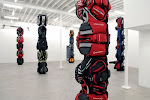
The National Museum of the American Indian is an institution that embodies the “identity” crisis of Native American culture in the 21st century. The victors in Native American history were the dominating white infiltration of the Europeans and later the Americans and their Western Frontier. Centuries of cultural assimilation and degradation have taken its toll on Native American tribes. An institution such as this is essential in ensuring the survival and accurate portrayal of Native American culture today. Without the museum many Native American customs and art would lose their voice and potency, or may be forgotten altogether. With this in mind, my experience with the museum was an experience confronting Native American identities. Often my perception of traditional values and customs seem paradoxical to existing in a contemporary society, but what the current exhibitions are proving is that Native American traditions are not conflicting or assimilating into the 21st century but rather evolving with time.
The exhibitions Our Lives: Contemporary Life and Identities and Ramp It Up: Skateboard Culture in Native America exemplify two opposite ends of a bell-curve in contemporary American Indian identity. The overtly non-traditional world of skateboarding becomes a vessel to promote traditional Native American values of work ethic and craft to a youthful generation. Our Lives: Contemporary Life and Identities articulates the struggle amongst eight Native communities—the Campo Band of Kumeyaay Indians (California, USA), the urban Indian community of Chicago (Illinois, USA), Yakama Nation (Washington State, USA), Igloolik (Nunavut, Canada), Kahnawake (Quebec, Canada), Saint-Laurent Metis (Manitoba, Canada), Kalinago (Carib Territory, Dominica), and the Pamunkey Tribe (Virginia, USA)* -- to retain cultural integrity and identity in the world today. The first time I experienced The National Museum of the American Indian was last spring and I was extremely moved by the work in Fritz Scholder’s (1937-2005) Retrospective: Fritz Scholder: Indian/Not Indian. Scholder’s work was exploring the myth of the American Indian and American Indian identity, including his own. Aesthetically Scholder’s paintings embody a sense of post-modern Abstract Expressionism and exploit Native American identity with a Pop-Art flair. Scholder’s controversial depictions of Native American’s appear to be a cultural critique of Native American identity. Scholder is grappling with his own Native American identity and his aesthetic struggle really embodies the Native American “identity” crisis in not only contemporary art but also in contemporary society today. The National Museum of the American Indian is a great arena for these cultural challenges to express themselves in a 21st century setting while still remaining true to its traditional roots.

No comments:
Post a Comment